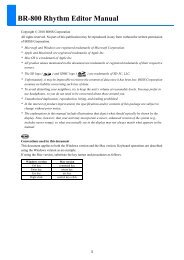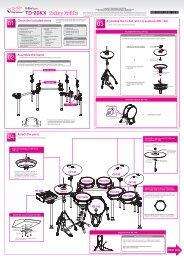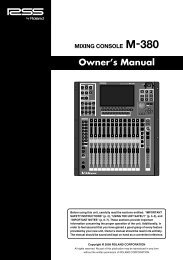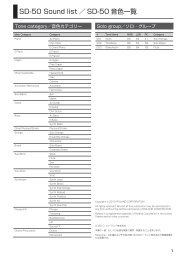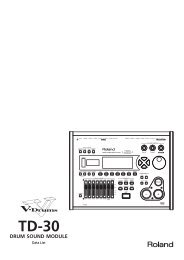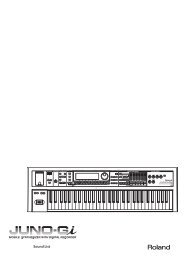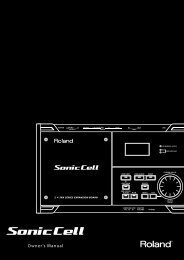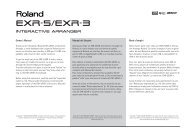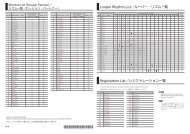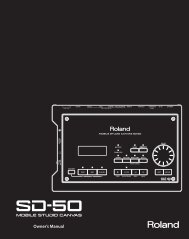GAIA Exploring Sound (PDF) - Roland Corporation Australia
GAIA Exploring Sound (PDF) - Roland Corporation Australia
GAIA Exploring Sound (PDF) - Roland Corporation Australia
Create successful ePaper yourself
Turn your PDF publications into a flip-book with our unique Google optimized e-Paper software.
If we were to lower the bass control, and raise the treble:<br />
Figure 4.4 Bass down, Treble up<br />
remove any larger particles or impurities. This is another type of<br />
filter.<br />
Remember how we explained Subtractive Synthesis? We said<br />
that we were “subtracting Harmonics.” So, unlike the tone<br />
controls in Figure 4.3, we could better represent the shape of a<br />
Filter control with this diagram:<br />
Figure 4.5 Extreme Filter<br />
Notice how we hear the changes. By raising the bass control we<br />
can emphasize the sound of the bass, or we could lower its<br />
sound by lowering the bass tone control. The same for the<br />
piccolo using the treble control. However, even at extreme<br />
settings we can still hear both instruments.<br />
So now recall what happened in Lesson Three when we lowered<br />
the “Tone Control” on the <strong>GAIA</strong>. The control labelled “Cutoff.” At<br />
it’s extreme low setting we were able to completely remove all<br />
sound. So it is very clear that the Tone Control of the <strong>GAIA</strong> is<br />
much more powerful than that of a stereo amplifier.<br />
The Filter<br />
Perhaps you have studied Chemistry and used filters before. In<br />
that case you will know that you can remove particles from a<br />
liquid by passing the liquid through a paper filter. Or perhaps<br />
while cooking you have passed flour through a sieve in order to<br />
Level<br />
Frequency<br />
It shows the Harmonic series of a Sawtooth waveform as we<br />
discovered in Lesson Three. Notice how the top two Harmonics<br />
have not just been lowered, as with a typical tone control. They<br />
have been removed altogether. To put it another way, they have<br />
been “cut off.”<br />
So we refer to the point shown by the arrow as “The Cutoff<br />
Frequency,” or just Cutoff for short. All harmonics above the<br />
Cutoff have been removed, and all those below the Cutoff are<br />
allowed to pass through the filter.<br />
44




